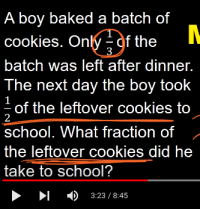Good morning,
Thank you in advance for reading this question. It's not a homework question. I saw the question on YouTube. It's about fractions word problems.
A boy baked a batch of cookies. only 1/3 of the batch was left after dinner. The next day the boy took 1/2 of the leftover cookies to school. What fraction of the leftover cookies did he take to school?
Our son is in year 6 and we want to help him. The answer is not given.
I really appreciate your help how to solve this problem (method)
Thank you in advance for reading this question. It's not a homework question. I saw the question on YouTube. It's about fractions word problems.
A boy baked a batch of cookies. only 1/3 of the batch was left after dinner. The next day the boy took 1/2 of the leftover cookies to school. What fraction of the leftover cookies did he take to school?
Our son is in year 6 and we want to help him. The answer is not given.
I really appreciate your help how to solve this problem (method)

